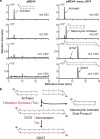Identification of a protein responsible for the synthesis of archaeal membrane-spanning GDGT lipids
- PMID: 35318330
- PMCID: PMC8941075
- DOI: 10.1038/s41467-022-29264-x
Identification of a protein responsible for the synthesis of archaeal membrane-spanning GDGT lipids
Abstract
Glycerol dibiphytanyl glycerol tetraethers (GDGTs) are archaeal monolayer membrane lipids that can provide a competitive advantage in extreme environments. Here, we identify a radical SAM protein, tetraether synthase (Tes), that participates in the synthesis of GDGTs. Attempts to generate a tes-deleted mutant in Sulfolobus acidocaldarius were unsuccessful, suggesting that the gene is essential in this organism. Heterologous expression of tes homologues leads to production of GDGT and structurally related lipids in the methanogen Methanococcus maripaludis (which otherwise does not synthesize GDGTs and lacks a tes homolog, but produces a putative GDGT precursor, archaeol). Tes homologues are encoded in the genomes of many archaea, as well as in some bacteria, in which they might be involved in the synthesis of bacterial branched glycerol dialkyl glycerol tetraethers.
© 2022. The Author(s).
Conflict of interest statement
The authors declare no competing interests.
Figures




Similar articles
-
Tetraether archaeal lipids promote long-term survival in extreme conditions.Mol Microbiol. 2024 May;121(5):882-894. doi: 10.1111/mmi.15240. Epub 2024 Feb 19. Mol Microbiol. 2024. PMID: 38372181 Free PMC article.
-
GDGT cyclization proteins identify the dominant archaeal sources of tetraether lipids in the ocean.Proc Natl Acad Sci U S A. 2019 Nov 5;116(45):22505-22511. doi: 10.1073/pnas.1909306116. Epub 2019 Oct 7. Proc Natl Acad Sci U S A. 2019. PMID: 31591189 Free PMC article.
-
Calditol-linked membrane lipids are required for acid tolerance in Sulfolobus acidocaldarius.Proc Natl Acad Sci U S A. 2018 Dec 18;115(51):12932-12937. doi: 10.1073/pnas.1814048115. Epub 2018 Dec 5. Proc Natl Acad Sci U S A. 2018. PMID: 30518563 Free PMC article.
-
Chemical markers for rumen methanogens and methanogenesis.Animal. 2013 Jun;7 Suppl 2:409-17. doi: 10.1017/S1751731113000694. Animal. 2013. PMID: 23739482 Review.
-
The essence of being extremophilic: the role of the unique archaeal membrane lipids.Extremophiles. 1998 Aug;2(3):163-70. doi: 10.1007/s007920050056. Extremophiles. 1998. PMID: 9783161 Review.
Cited by
-
Lipidomic diversity and proxy implications of archaea from cold seep sediments of the South China Sea.Front Microbiol. 2023 Oct 19;14:1241958. doi: 10.3389/fmicb.2023.1241958. eCollection 2023. Front Microbiol. 2023. PMID: 37954235 Free PMC article.
-
Cyclization of archaeal membrane lipids impacts membrane protein activity and archaellum formation.Proc Natl Acad Sci U S A. 2025 May 20;122(20):e2423648122. doi: 10.1073/pnas.2423648122. Epub 2025 May 12. Proc Natl Acad Sci U S A. 2025. PMID: 40354536
-
Discovering Hidden Archaeal and Bacterial Lipid Producers in a Euxinic Marine System.Environ Microbiol. 2025 Mar;27(3):e70054. doi: 10.1111/1462-2920.70054. Environ Microbiol. 2025. PMID: 40016913 Free PMC article.
-
Nitrosopumilus as main source of isoprenoid glycerol dialkyl glycerol tetraether lipids in the central Baltic Sea.Front Microbiol. 2023 Sep 28;14:1216130. doi: 10.3389/fmicb.2023.1216130. eCollection 2023. Front Microbiol. 2023. PMID: 37840736 Free PMC article.
-
Tetraether archaeal lipids promote long-term survival in extreme conditions.Mol Microbiol. 2024 May;121(5):882-894. doi: 10.1111/mmi.15240. Epub 2024 Feb 19. Mol Microbiol. 2024. PMID: 38372181 Free PMC article.
References
-
- Valentine DL. Adaptations to energy stress dictate the ecology and evolution of the Archaea. Nat. Rev. Microbiol. 2007;5:316–323. - PubMed
-
- Schouten S, Hopmans EC, Damsté JSS. The organic geochemistry of glycerol dialkyl glycerol tetraether lipids: a review. Org. Geochem. 2013;54:19–61.
-
- Lai D, Springstead JR, Monbouquette HG. Effect of growth temperature on ether lipid biochemistry in Archaeoglobus fulgidus. Extremophiles. 2008;12:271–278. - PubMed
Publication types
MeSH terms
Substances
LinkOut - more resources
Full Text Sources
Other Literature Sources
Molecular Biology Databases

